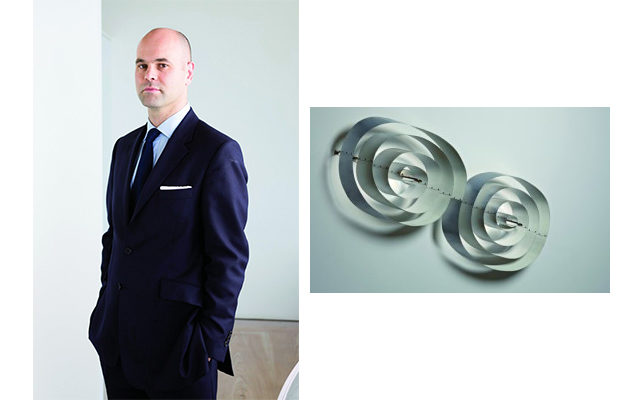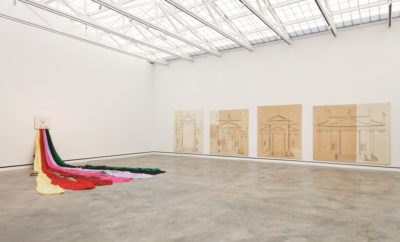
Design
Taking Stock at Phillips

ALEXANDER PAYNE: PHILLIPS DE PURY and COMPANY’s WORLDWIDE DIRECTOR OF DESIGN
Scoot back to 1999 and Phillips de Pury and Company’s entire design department pulled in a scant $500,000. But fast-forward to 2011, and Alexander Payne, the firm’s worldwide head of design, hammered down a staggering $22 million. He’s also been blazing a trail when it comes to Nordic design. This past September he sold a 1944 Axel Salto vase for a hefty $600,933 to a phone bidder. He also recently achieved steep prices with Poul Henningsen’s Double Spiral wall light going for $399,375, and a new Vilhelm Lauritzen sofa selling for $111,730.
Other high flying prices include Marc Newson’s 1988 prototype for his Lockheed lounge with white feet, which, though estimated at $1–$1.5 million, skyrocketed to a record $2,098,500 in May 2010, the highest price ever paid for a chair. Emile-Jacques Ruhlmann’s pair of Gonse armchairs, was expected to fetch $600,000 to $800,000 and soared to an impressive $1,426,500 in 2011. Mies van der Rohe’s rare chrome-plated steel and glass Tugend-hat coffee table jumped to $351,707.

Monumental Double- Spiral wall light designed by Poul Henningsen, made for the Scala Cinema and Concert Hall in Arhus, Denmark, 1955.
MODERN Magazine turned to Payne to glean the latest shifts in today’s fast-paced market, to see what he sees his clients plucking up in these millennium times, and what’s on the horizon.
When you first joined Bonhams, the market must have seemed a buyer’s paradise. What were the prices then?
In 1996 prices hovered in the $5,000 to $6,000 range for François-Xavier and Claude Lalanne and many other designers, like Marcel Breuer. Even so, great collectors and dealers along with museums were emerging as players. Those clients still remain the backbone of today’s market.
What is driving the market today?
Without question, new exhibitions and fairs internationally. Look at the London Design Festival, which drew 350,000 visitors in 2012, or take the Venice Biennale for Architecture in September, when the Alvar Aalto-designed Finnish Pavilion in native birch and European pine was seen by an entire new crop of enthusiasts. That will impact the market for Nordic design, where we are already seeing a spike in prices.
And the biggest shift you’ve been witnessing?
As we turned the millennium, the market exploded exponentially. So there’s a far greater number of collectors, curators, and art advisors looking back and looking forward.
Who are the new entrants to the market?
The field is flooded with new buyers, and they’re coming from Asia, Eastern Europe, the Nordic countries, then down to the Persian Gulf region and across to Latin America as well.
Ceramics had been a minor footnote in design auctions until you elevated that specialty area. What’s propelling ceramics as the new collectible?
Ben Williams, who oversees ceramics for us, is seeing collectors understand that vessels are a natural bridge between architecture and design. That’s sparking prices like the late Los Angeles ceramist Ken Price’s sculpture Steeps bringing $98,500 at our recent June auction. Part of the reason for price jumps is that we’ve broken down the barriers between craft and contemporary design. Plus, ceramics provide an appealing entry point. For example, pieces by Edmund de Waal, whose work can be found in the Victoria and Albert Museum among others, can be picked up for low four-figure sums.
We’ve known that collectors of contemporary art have been crossing over into design for some time. But what other shifts are taking place?
Art deco enthusiasts are moving into Bauhausmaterials while postwar paintings collectors are journeying into earlier design like Wiener Werkstätte. At the same time contemporary art fans are exploring glass by Carlo Scarpa and Venini.
Are there some relatively new interior designers showcasing modern and contemporary design?
Alongside Peter Marino, Lee Mindel, Michael Smith, and Jacques Grange, we’re seeing Ilse Crawford in London and India Mahdavi in Paris playing a critical role in incorporating such examples. They’re taking on restaurant and hotel designs that translate to greater exposure to a wider audience.
To what degree are art museums increasing their holdings?
Overall institutions are taking on a greater role. Craig Miller is building a formidable collection for the Indianapolis Museum of Art and the London Design Museum is growing in strength.
What’s next on museum wish lists?
World-class postwar design by world-class Shiro Kuramata and Mies van der Rohe. Yet the spotlight has also moved to contemporary designers such as Ron Arad, Marc Newson, Max Lamb, and Nendo.
What’s on the horizon in terms of collecting?
There’s far greater interest in architecture, with many following the lead of Lord Palumbo by acquiring important postwar buildings and some patrons commissioning new work. That enthusiasm is influencing a new generation of collectors. Many are looking at Thomas Heatherwick, whose studio is turning out both architecture and design. This more expansive collecting is further elevating the entire field.

Sofa by Vilhelm Lauritzen for the Radiohuset, Frederiksberg, Denmark, 1942.












